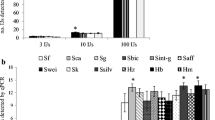Abstract
A new technique for the quantitative detection of Chalara elegans and C. thielavioides in soil based on the combination of a soil dilution technique with carrot disc baits was developed. The quantitative Chalara test was validated in replicated experiments using mineral and organic soils in our laboratory. The test allowed detection of a population density of 1 cfu 0.1 gt-1 fresh soil. Efficiency, repeatability and dependability of the test were regarded as acceptable and this was confirmed by an international ring test with 7 participating laboratories. With the quantitative Chalara test, the influence of crop cultures or green manures on the population densities of C. elegans and C. thielavioides in the soil can be assessed.
Similar content being viewed by others
References
Heller W, 2000. Schwarzfleckenpilze: unterschätzte Krankheitserreger der Karotte? Agrarforschung 7 (9), 420–423.
Hood ME & Shew HD, 1997. Development of resting hyphae and aleuriospore induction of Thielaviopsis basicola Mycologia 89, 793–800.
Kägi A, Crespo P, Baur R, Bertschinger L, Höhn E & Heller W, 2007. Qualitätssicherung in der Karotten-Produktionskette. Proj ektbericht. http://www.qs-karotten.ch/documents/Projektbericht.pdf.
Punja ZK & Chittaranjan S, 1994. Prevalence and inoculum density of Chalara elegans in soils in the Fraser Valley of British Columbia. Can J Plant Pathol 16, 21–24.
Rittenhouse CM & Griffin GJ, 1985. Pattern of Thielaviopsis basicola in tobacco field soil. Can J Plant Pathol 7, 377–381.
Specht LP & Griffin GJ, 1985. A selective medium for enumerating low populations of Thielaviopsis basicola in tobacco field soils. Can J Plant Pathol 7, 438–441.
Tabachnik M, DeVay JE, Garber RH & Wakeman RJ, 1979. Influence of soil inoculum concentrations on host range and disease reactions caused by isolates of Thielaviopsis basicola and comparison of soil assay methods. Phytopathology 69, 974–977.
Weber RWS & Tribe HT, 2004. Moulds that should be better known: Thielaviopsis basicola and T. thielavioides, two ubiquitous moulds on carrots sold in shops. Mycologist 18, 6–10.
Yarwood CE, 1946. Isolation of Thielaviopsis basicola from soil by means of carrot discs. Mycologia 38, 346–348.
Yarwood CE, 1974. Habitats of Thielaviopsis in California. Plant Dis Rep 58, 54–56.
Yarwood CE, 1981. The occurrence of Chalara elegans Mycologia 73, 524–530.
Author information
Authors and Affiliations
Corresponding author
Rights and permissions
About this article
Cite this article
Heller, W.E. A new method of quantitative detection of Chalara elegans and C. thielavioides in soils using carrot discs. J Plant Dis Prot 119, 169–173 (2012). https://doi.org/10.1007/BF03356437
Received:
Accepted:
Published:
Issue Date:
DOI: https://doi.org/10.1007/BF03356437




